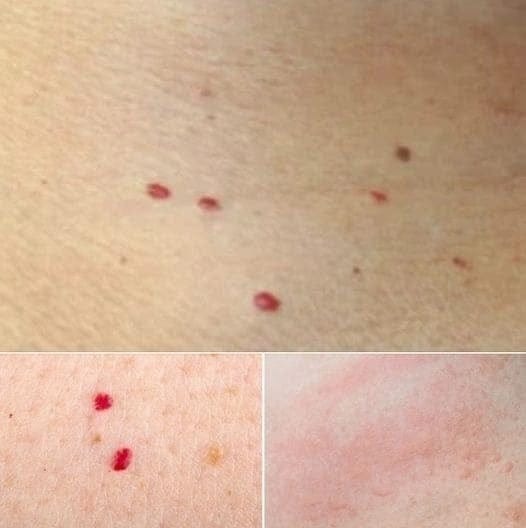ADVERTISEMENT
**Causes of Cherry Angiomas:**
– **Age:** Cherry angiomas become more common with age. They often appear in people over the age of 30 and increase in frequency as a person gets older.
– **Genetics:** Some individuals may be genetically predisposed to developing cherry angiomas.
– **Hormonal Changes:** Hormonal changes, such as those experienced during pregnancy or with certain medications, can trigger the development of cherry angiomas.
**What to do:** Cherry angiomas are harmless and do not require treatment unless they become painful, bleed, or are cosmetically bothersome. In some cases, a dermatologist may remove them using cryotherapy (freezing), laser treatment, or electrosurgery.
#### 1.5 **Allergic Dermatitis**
Allergic dermatitis, or allergic skin reactions, can cause red, itchy bumps to appear on the skin. These reactions are typically caused by an allergy to substances like certain foods, plants (e.g., poison ivy), or chemicals in skincare products.
**Causes of Allergic Dermatitis:**
– **Contact with Allergens:** Substances like certain metals (nickel), fragrances, or plants can cause allergic reactions that lead to red bumps or rash-like patches on the skin.
– **Food Allergies:** Certain foods, such as peanuts or shellfish, can cause allergic reactions that result in red bumps or hives on the skin.
**What to do:** Identifying and avoiding the allergen is the best way to prevent allergic dermatitis. Over-the-counter antihistamines or hydrocortisone creams may help reduce itching and inflammation. In severe cases, a doctor may prescribe stronger medications or corticosteroids.
#### 1.6 **Infections (Fungal or Bacterial)**
Infections can also cause red dots or spots on the skin. Fungal infections like ringworm, for example, can cause a circular red rash, while bacterial infections like impetigo can lead to red sores or blisters.
**Causes of Infections:**
– **Fungal Infections:** Fungal infections like ringworm (tinea corporis) or athlete’s foot (tinea pedis) can result in red, scaly patches or dots on the skin.
– **Bacterial Infections:** Impetigo, a highly contagious bacterial infection, causes red sores or blisters that may rupture and form a yellow-brown crust.
**What to do:** If you suspect an infection, it’s essential to see a healthcare provider for an accurate diagnosis and treatment plan. Fungal infections are usually treated with antifungal creams or oral medications, while bacterial infections may require antibiotics.
#### 1.7 **Sunburn**
Sunburn can also cause red spots to form on the skin, especially if you’ve been exposed to the sun for prolonged periods without proper protection. Sunburn may appear as red, inflamed skin that can develop into blisters in more severe cases.
**Causes of Sunburn:**
– **Excessive Sun Exposure:** Prolonged exposure to the sun’s ultraviolet (UV) rays can damage the skin and cause sunburn, which can lead to redness, peeling, and discomfort.
**What to do:** To treat sunburn, apply aloe vera or other soothing creams to the affected area. It’s also important to stay hydrated and avoid further sun exposure. In severe cases, over-the-counter hydrocortisone cream or ibuprofen may be used to reduce inflammation and pain.
### 3. **When to Seek Medical Help**
While most red dots on the skin are benign and resolve on their own, some cases may require medical attention. Here are some red flags that indicate you should see a healthcare provider:
– **Widespread or Persistent Spots:** If red spots appear all over your body and do not improve, seek medical help.
– **Accompanying Symptoms:** If you experience fever, fatigue, pain, or swelling along with red spots, this may indicate an infection or another underlying health issue.
– **Changes in Appearance:** If the red spots change in size, shape, or color, or if they bleed or become painful, you should consult a doctor for further evaluation.
– **Recent Trauma or Injury:** If the red dots appeared after physical trauma (e.g., heavy lifting, injury, or surgery), it may indicate a more serious condition that needs medical attention.
### 4. **Prevention of Red Dots on the Skin**
Preventing red dots from appearing in the first place often involves taking good care of your skin and managing underlying conditions. Here are some tips to prevent red dots on your skin:
– **Maintain Good Hygiene:** Keeping your skin clean and free of irritants can help prevent many skin conditions.
– **Use Sunscreen:** Protect your skin from sunburn by applying sunscreen with a broad-spectrum SPF of 30 or higher.
– **Manage Allergies:** If you have known allergies, take steps to avoid allergens and carry antihistamines as needed.
– **Stay Cool:** Avoid excessive sweating in hot, humid environments to prevent heat rash and clogged sweat glands.
– **Avoid Scratching:** Scratching red dots or rashes can worsen the condition and lead to further irritation or infection.
### 5. **Conclusion**
Red dots on the skin can be caused by a variety of factors, ranging from harmless conditions like heat rash and cherry angiomas to more serious issues like petechiae or infections. By understanding the potential causes and symptoms associated with red dots, you can take appropriate steps to address them, whether it’s through at-home treatments or seeking medical help. If you’re ever unsure about the cause of your red spots, it’s best to consult with a healthcare provider to ensure you get the right diagnosis and treatment.
